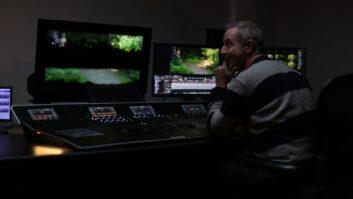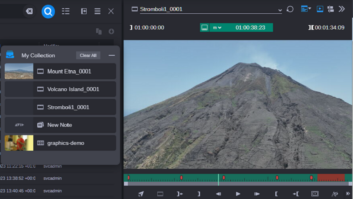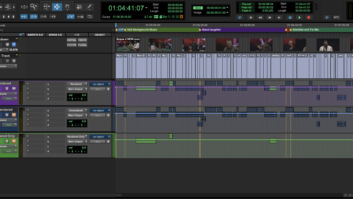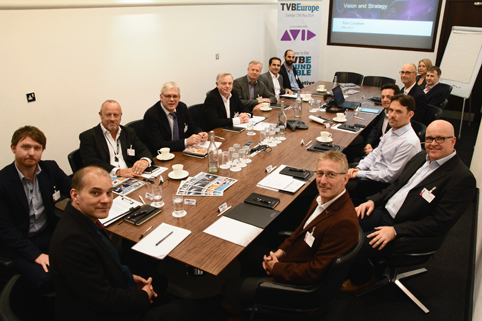
Last month, TVBEurope, in association with Avid, hosted another of its successful industry roundtables. Acting editor Neal Romanek was there.
The latest TVBEurope roundtable, entitled ‘Collaborative Workflows’, roundtable was held at London’s landmark BT Tower. Its purpose was to gather industry leaders to analyse and share common challenges in the brave new world of file-based workflows. Many thorny issues were raised, including the conundrum that file-based workflows often fuel the very fires they aim to put out.
The reception afterward was held high atop BT Tower, and featured a stunning view of a rain-drenched London, accompanied by a double-rainbow – perhaps a sign that the stormy world of digital workflows would eventually have a happy ending.
Industry participants willing to put all their workflow problems on the table were (anticlockwise from top left in the image above): Ammar Hijazi, TIMA head of operations; Alla Salehian CEO of TIMA; Paul Stevenson, director of technology and technical operations at ITV News; Philip Stevens, TVBEurope contributor and moderator of the session; Jose de Freitas, CTO of Ireland’s TV3; Mark Wilson-Dunn, VP sales and marketing at BT Media and Broadcast; James McKeown, executive editor TVBEurope; Neal Romanek, acting editor TVBEurope; Martyn Suker, head of production innovation at ITV Studios; Craig Dwyer, senior director Global Center of Excellence at Avid; Ian Draysey, manager, post production engineering at Discovery; Steve Bennedik, head of technology at Sky News; Tom Cordiner, VP international sales at Avid; Steve Fish, RVP technology and operations at Turner Broadcasting Systems Europe, and Stephanie Genin, EMEA Field Marketing Director, Avid.
Workflows in the broadcast industry are being challenged by file-based implementations, and a project’s journey from concept to delivery is no longer the linear path it once was. Like many industries, broadcast has adopted change slowly, but in the past year, a tipping-point in file-based workflows and IP delivery has been reached. An IT-rate of change, much more rapid than the slower, hardware-centric rate of change of a decade ago, has hit the industry like a hurricane. But there are payoffs in upending the old workflows. Suddenly, whole new vistas have opened for creative collaboration and content distribution.
How can broadcasters and content producers rethink their workflows in this new collaborative environment, where the workflow model is now more ecosystem than assembly line? And what needs to be preserved from the old, linear models of production? These were the central questions the roundtable aimed to address.
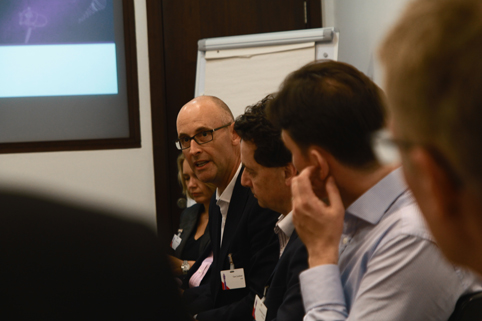
Tom Cordiner of Avid lead the charge, opening the roundtable with an introduction to the company’s Avid Everywhere concept of production workflows. Avid Everywhere is the vision developed by Avid’s new forward-looking CEO, Louis Hernandez, Jr. Avid Everywhere aims to reimagine the entire production workflow to more realistically represent current, “non-linear” modes of collaboration. No one can doubt Hernandez’s commitment to the new Avid vision – uncharacteristic of incoming tech executives, Hernandez signed a five-year contract with Avid, and owns a 30% stake in the company. “Avid is a fundamentally different company to the one I joined,” began Cordiner, “(Louis) is very committed to driving the change through Avid, and thus through the industry, that we feel is certainly happening.”
Days before NAB2014, Avid hosted its first Avid Customer Association event. The event was far more successful than the company had hoped, with an anticipated turn-out of 500 people turning into 1100. Roundtable participants Paul Stevenson and Martyn Suker, both of ITV, are members of the Avid Customer Association with Stevenson on the main board and Suker on the advisory council.
So what are the industry changes Avid is taking on? According to Cordiner: “The first, we think, is this collapsing of the value chain between the creative part of our businesses and the go-to-market, commercial monetisation piece. Because everything is created digitally now, it’s creating a very profound change in how companies operate. The second thing we see is this fight for viewership. Viewers are now very much in control of how and where they choose to watch content.”
Cordiner said that Avid’s customers all talk about a relentless pressure on operational efficiency and that they are still required to create the most efficient workflows they can in the mindset of the changing media landscape.
“Because of the way the digital shift has impacted traditional television and media companies, we now have the ability to distribute and make money from the content at the same time they are actually capturing and creating it.”
“You don’t have a team of creatives building content and deciding what’s going to be broadcast, and then a separate team deciding how they’re going to make money from it. It’s all happening at the same time now. When we talk to the boards of some of our biggest customers, their number one challenge, they say, is ‘How do I bring these two parts of my business together?’”
New workflows, new challenges

With the basis of the conversation established, Philip Stevens opened the group discussion with an anecdote about the workflow before the digital age: “I may be the oldest person in this room and I can remember the workflow in my day, when I started off as a runner in a film production company half a mile away from here, I had to be at a film laboratory about two streets away from here at 8 o’clock in the morning collecting the rushes, getting back to the cutting room and having to log them before the editor came in at half past nine to view them with the director. The workflow was me. Things have obviously moved on a great deal.”
Stevens asked the panel what key challenges they faced today with regard to optimising the media that they already had, directing the question first to ITV’s Paul Stevenson, a member of Avid’s ACA.
Stevenson first reiterated Avid’s level of commitment and remarked how well organised the pre-NAB Avid Customer Association event was with a massive industry presence. The problem facing them, he said, was not how small the industry was, but how many players and standards there were within it. “And that’s the prize for Avid, to harmonise that…But it’s also a huge challenge, because we all know how broadcasters like to do things their own way. We talk about standardisation, but sometimes we don’t really mean it.”
He thought it was interesting how Avid had illustrated the breaking up of the value chain from its pre-digital linear roots. “That old linear chain is quite familiar to all of us. How we now publish material is much more in the hands of producers than it used to be, and the technology needs to match that.”
Steve Bennedik of Sky News thought Avid’s vision was pertinent to the needs of news organisations, which were becoming increasingly multiplatform. His main question for all-encompassing propositions like those presented by Avid is how willing are companies to put all their eggs in one basket. “It’s like going to the High Street to buy your clothes. Do you go to a trusted, reliable source to get your suit? Or do you go somewhere and mix-and-match, which could be a bit more daring, but you might end up with something a bit more colourful and modern? And the other thing in that scenario – as I inevitably move to a 36-inch waist – is Avid going to be able to cope with change on an ongoing basis?”
Discovery’s Ian Draysey: “For us, as we expand globally, it’s being able to share content around regional offices and trying to move away from shifting heavy assets about. We want to work with third parties and external vendors and give them access to work on our content with us and collaborate internally and externally.”
Steve Fish at Turner Broadcasting Europe said that his company favoured the ‘mix-and-match’ approach. “We haven’t bought one suit from one place. And we’re driven to that because of the diverse nature of the business. We end up having to place disparate systems in different places to align with the creative need. But the challenge then is to integrate them. That’s the most crucial part.”
“Systems going forward have to become much more flexible and much more dynamic,” Fish went on to say, “We can no longer build a system with a five year life cycle. There is no way you can now build a system that takes you more than six to 10 months, because by the time you’re at the end of 10 months, the industry’s passed you. The next thing’s happening.” He pointed to the BBC’s Digital Media Initiative as an example of a project existing in an entirely unrealistic time scale.
“I think flexible API-driven workflow systems are going to be crucial for us as an industry to survive. It’s not about a single vendor or partner, it’s about how we work together. I had a visit from a big software company who promised our CFO, ‘We can solve all of your problems. You don’t need any of that broadcasty stuff. We’ll solve it all for you.’ We all know it’s much, much more difficult than that, but if they say they can come in and halve the price, that gets people’s attention.”
“It’s a good stick for the IT industry to beat the broadcast industry with, isn’t it?,” noted ITV’s Stevenson, “That it’s kind of disparate and doesn’t have any standards. ‘You’re just a mess of standards and there’s no coherence; everyone’s doing everything differently’”.
Stevenson said that in the final analysis, “we still need a platform where we do all our stuff”, that a certain amount of stability was required in a platform. Steve Fish agreed, but said that it was essential to be able to incrementally improve platforms, without having to change the whole platform. A new automation system for playout is not something that can be changed quickly.
Scheduling systems are one example of an essential enterprise-wise system that seems ubiquitously difficult to manage and upgrade. Fish said that Turner was undergoing an assessment of its own scheduling system. “These systems are so monolithic and so huge, that actually companies are frightened to do anything about it.”
There was laughter around the table as participants recognised the same thorny hurdles in their own organisations. Stevenson concurred: “There are some things so entrenched in your business and so huge that even if they are a bit flakey and crude and clunky, you stick with them because changing them is so difficult and costly.
Competing screens
Alla Salehian of TIMA asked the roundtable what they thought the timescale will be of the evolution away from linear workflows and delivery. As a news agency, TIMA deals with a great deal of user generated content – which can be globally available before a traditional broadcaster even gets wind of the story. Given that 40% of global advertising revenue is still driven by broadcast, the transition might be slower than we think. “I think what Avid is doing is absolute right, but how long will it take?”
Tom Cordiner believed the two value chains would coincide for a long time. He pointed to the variability between markets. In India, for example, there is a large population that gets its information largely from traditional broadcast, whereas other more developed markets have adopted a more varied value chain.
BT’s Mark Wilson-Dunn added, “The latest research that we’ve commissioned at BT Media and Broadcast suggests that something like 98% of viewing eyeballs in the UK are still watching a linear TV experience. You switch on and say ‘Feed me.’ And I can’t see that changing.”
Wilson-Dunn believed that audiences will ultimately choose the viewing option that is is most convenient and effective for them. “You default to the choice that most fits your lifestyle or your condition at the time. If I’m watching a football game or a movie, I’ll watch it on the biggest device possible. But if I’m stuck on a train, I’ll watch it on an iPad. Now if you look at the viewing habits of kids, they will multitask across everything. Another thing is that the brand loyalty to a particular channel is gone. There’s brand loyalty toward particular programmes.”
Though user-generated content has begun to play an increasing role in informational media, especially news, Wilson-Dunn doesn’t see it replacing traditional news gathering. He brought up his experience of the Cutty Sark fire – the initial coverage was user-generated video captured on the scene. The access was immediate, but after the continuous repeating of the video by the broadcasters, Wilson-Dunn found himself craving proper analysis and coverage from the scene by professional journalists. “I think that has fed back into the news organisations. News now has gotten a lot more compelling, there’s a lot more information, the format’s a lot better. I don’t see a generational shift away from linear TV happening any time soon, but I think the choice of being able to consume media at different times and different places is absolutely there.”
ITV Studios’ head of production innovation, Martyn Suker, believed there would be parallel universes of old and new running side by side for some time, both from the consumer point of view, and within the production environment. “How long will it take for that to change? Probably twice as long as you think.”
Twenty-five major players, 400,000 small businesses

Wilson-Dunn expressed admiration for Avid’s unified, all-encompassing vision, but was concerned that the dominance of a single player could exclude opportunities for small companies and innovators. “My observations at NAB and IBC last year is that the market for workflow is starting to mature. It’s starting to actually have some deliverables. With Sony, Prime Focus, Avid, and HP back in the market, people are going to choose different platforms, as much as we’d like to see one dominating platform. It’s the interoperability between platforms that is the big question for me. We know that ecosystem in this marketplace is probably 25 major players worldwide and then 400,000 small businesses based in lofts and garages. How do those small businesses get along?”
Avid’s Craig Dwyer said that the UK’s DPP deadline, coming up in October has helped force the industry into maturity, by encouraging an agreement on common standards. He noted that Avid now has a variety of options available for users, including monthly subscription licenses.
Jose de Freitas of TV3 in Ireland addressed the issue of small broadcaster operability based on his own experience: “Obviously, representing the smallest organisation in the room, one of the interesting things is a subscription-type model that facilitates the ups and downs in the production cycle.
Tom Cordiner believed that Avid was offering a flexible model that served the interests of both big and small companies alike. “It depends on workflow and what organisations are trying to achieve. If you’re a big broadcaster like RAI in Italy, where you might have hundreds of editors or journalists working, and flexing up to buy 20 or 40 licenses isn’t such a critical thing. But if you’re a small production house in Soho and have peaks and troughs in use, it’s a very different thing. But we have the option to float licenses around different user groups. I think we scale across from independents all the way up to big organisations. You can rent Media Composer for £10 a month, if that’s what you want to do.”
“I think that’s Avid’s winning proposition,” responded Wilson-Dunn. “It’s that scene of the creative organisations at the sub-five people level that drives the rest.”
Paul Stevenson was cautious, but hopeful: “Broadcasters have the big end infrastructure that does exclude a lot of small third parties. That connection for third parties still feels like a challenge to me. It feels like there’s a cost overhead to join the party, and anything that eliminates that, I think helps the cause.”
Culture change
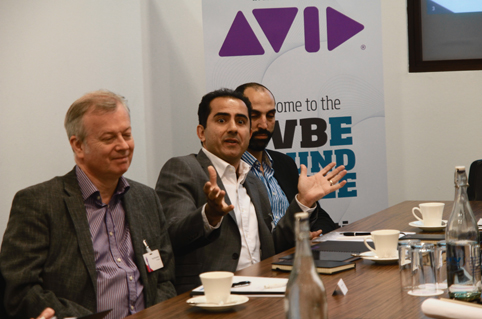
Though much of the conversation had been about the difficulties of effectively managing and leveraging new technology. Martyn Suker said that the big issue was not technological change, but that it was – particularly in a production environment – culture change.
Suker noted that there is a common conception that moving around media in the digital realm is easier. “But I’m not sure that it is, actually. We’re entering an environment now where we’ve got a hell of a lot more media than we used to have in a tape-based environment. It’s gone crazy in the file-based world. And managing that has become much more difficult. We’ve almost lost control of it. Why have we got more? Because we can. And because we’ve got a lot more people who are self-shooting these days. And because we’ve lost sight of what it means.
“If you had a 30-minute DigiBeta tape, if you shot five rolls in a day, you knew you got two and half hours. You knew what your shooting ratio was. What does a 64 gig card mean to anybody? You can fill it up and empty it and fill it up and empty it, and before you know where you are, you’ve got a hell of a lot of stuff to deal with. How do you do that seamlessly and move that around?”
The unstoppable deluge of files filling a workflow necessitates better and better metadata, but managing the metadata becomes as much, or more, of a challenge as managing the files themselves.
“It costs money to enter metadata. It costs time. And who knows what that metadata should be? The people who created the content in the first instance. And where do you want to use it? Everywhere else in your organisation. So the seamless flow of that metadata is absolutely vital. And that’s a thing that we really don’t do very well.”
Suker noted that the industry does have some common standards for metadata that have been around for some time, but broadcasters still don’t employ them consistently or effectively.
Suker’s assessment of the metadata problem was heartily seconded by the majority experience at the roundtable and the discussion that followed delved deep into the problem of metadata. Why aren’t broadcasters using it as well as they should – or could? And if metadata is the key to managing files, is successful metadata the royal road to a successful workflow?
Read Part 2 of our Avid Roundtable coverage in TVBEurope’s July issue.

